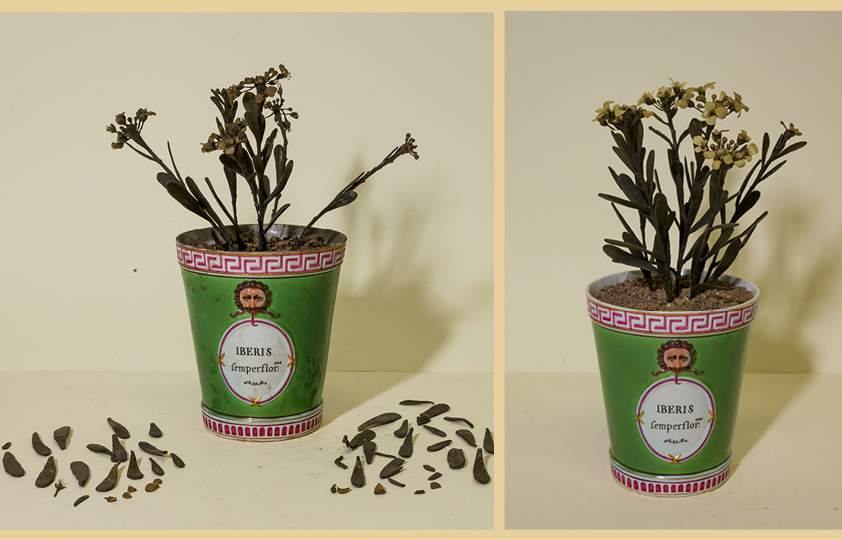Under the title Flowers, Leaves and Thorns. Wax Botanical Models from the Museum of the Specola in Florence, the Museo dell’Opificio delle Pietre Dure in Florence is exhibiting, at the conclusion of the restoration entrusted to the Opificio’s technicians, an astonishing selection of wax botanical models from the world’s unique collection of nearly 200 life-size botanical models from the Museum of the Specola in Florence. They will be offered at the Opificio Museum for the space of one month only, in an exhibit curated by director Laura Speranza.
Those on display at the Opificio Museum are masterpieces of ceroplastics, considered among the most beautiful in the world. The imitation of the real and the executive refinement of the ancient Florentine ceroplastists who created them during the 18th century still arouse awe. One admires, in particular, the creativity with which these artisans-artists drew on the use of a wide variety of materials to achieve natural effects, such as the addition of a silver dusting to achieve the surface shine of theEuphorbia canariensis, the addition of real thorns in cacti or the use of light plant filaments, similar to a spider’s web, to simulate the sort of downy fuzz found between the small succulent leaves of Sempervivum arachnoideum.
These wax plants document the extraordinary variety of the plant world known in the late 18th and early 19th centuries and were intended to amaze and educate the public of the Natural History Museum of Florence, which was commissioned by the Grand Duke of Tuscany, Peter Leopold of Lorraine, in 1775.
At the time, the Museum was endowed with a Ceroplastic Workshop where expert ceramics artists, in addition to making anatomical models, also produced these splendid botanical specimens identified by their scientific name, in Latin, according to the nomenclature introduced by Charles Linnaeus only a few years earlier(Species Plantarum, 1753).Each model is housed in an elegant porcelain vase from Doccia, produced in the well-known Ginori factory, a true emblem of the refined taste of its patron and of an era when science was accompanied by Beauty and Art. In the small exhibition at the Opificio Museum, prior to their display in the new La Specola exhibit to which it acts to some extent as an outrider, seven of the most interested botanical wax models can be appreciated, flanked by images of the corresponding plants found in Nature.
“Essential didactic apparatuses allow an in-depth study of the executive technique of the wax plants and of the activities carried out in the recently completed restoration, where the botanical consultancy of Chiara Nepi played a decisive role,” announced director Laura Speranza.
For her part, the Superintendent of the Opificio delle Pietre Dure, Emanuela Daffra, emphasizes how "the restoration of this group of precious artifacts is part of the Opificio delle Pietre Dure’s tradition of fruitful collaboration, through its materials, ceramic, plastic and glass restoration sector, with the Museum of Natural History for the recovery and maintenance of its rich heritage of wax works, from anatomical to botanical models." Lucilla Conigliello, Technical Director SMA- University of Florence, says, "As the Museum System of the University of Florence, we are really pleased to be able to give with this small exhibition a foretaste of the extraordinary work carried out by the Opificio delle Pietre Dure for the restoration of the botanical waxes that in a few months everyone will be able to appreciate in the new La Specola Museum display, which will be very impressive indeed. The debt of gratitude that binds us to the Opificio is great, for so many activities and interventions planned over the years, on assets that are also very different from each other. It is a privilege to be able to collaborate with officials and restorers of the highest profile, in shared intent, to ensure the conservation of unique works of art."
For all information, you can visit the official website of the Museo dell’Opificio delle Pietre Dure.
 |
| Florence, botanical wax models on display at the Museum of the Opificio delle Pietre Dure |
Warning: the translation into English of the original Italian article was created using automatic tools. We undertake to review all articles, but we do not guarantee the total absence of inaccuracies in the translation due to the program. You can find the original by clicking on the ITA button. If you find any mistake,please contact us.